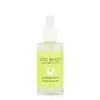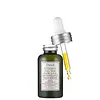What's inside
What's inside
 Key Ingredients
Key Ingredients

 Benefits
Benefits

 Concerns
Concerns

 Ingredients Side-by-side
Ingredients Side-by-side

Vitis Vinifera Juice
AntioxidantCitrus Aurantium Dulcis Juice
Skin ConditioningAloe Barbadensis Leaf Juice
Skin ConditioningGlycerin
HumectantTriethyl Citrate
MaskingGluconolactone
Skin ConditioningOenothera Biennis Oil
EmollientLinum Usitatissimum Seed Oil
PerfumingBorago Officinalis Seed Oil
EmollientVitis Vinifera Seed Oil
EmollientHelianthus Annuus Seed Oil
EmollientPullulan
Sodium Benzoate
MaskingLaminaria Ochroleuca Extract
Skin ConditioningUbiquinone
AntioxidantDimethylaminoethanol Tartrate
EmollientThioctic Acid
AntioxidantMagnesium Ascorbyl Phosphate
AntioxidantTocopherol
AntioxidantSodium Hyaluronate
HumectantSclerotium Gum
Emulsion StabilisingXanthan Gum
EmulsifyingSodium Stearoyl Glutamate
CleansingSodium Gluconate
Skin ConditioningCaprylic/Capric Triglyceride
MaskingAlcohol Denat.
AntimicrobialGluconic Acid
Sodium Hydroxide
BufferingCitrus Aurantium Bergamia Fruit Oil
MaskingCitrus Aurantium Dulcis Peel Oil
MaskingVitis Vinifera Juice, Citrus Aurantium Dulcis Juice, Aloe Barbadensis Leaf Juice, Glycerin, Triethyl Citrate, Gluconolactone, Oenothera Biennis Oil, Linum Usitatissimum Seed Oil, Borago Officinalis Seed Oil, Vitis Vinifera Seed Oil, Helianthus Annuus Seed Oil, Pullulan, Sodium Benzoate, Laminaria Ochroleuca Extract, Ubiquinone, Dimethylaminoethanol Tartrate, Thioctic Acid, Magnesium Ascorbyl Phosphate, Tocopherol, Sodium Hyaluronate, Sclerotium Gum, Xanthan Gum, Sodium Stearoyl Glutamate, Sodium Gluconate, Caprylic/Capric Triglyceride, Alcohol Denat., Gluconic Acid, Sodium Hydroxide, Citrus Aurantium Bergamia Fruit Oil, Citrus Aurantium Dulcis Peel Oil
Water
Skin ConditioningIsononyl Isononanoate
EmollientGlycerin
HumectantPentylene Glycol
Skin ConditioningPropanediol
SolventCocos Nucifera Oil
MaskingZingiber Officinale Water
MaskingPolymnia Sonchifolia Root Juice
Skin ConditioningCichorium Intybus Root Extract
MaskingVaccinium Myrtillus Fruit Extract
Skin ConditioningHelianthus Annuus Seed Oil
EmollientSaccharum Officinarum Extract
MoisturisingCitrus Aurantium Dulcis Fruit Extract
MaskingCitrus Limon Fruit Extract
MaskingAcer Saccharum Extract
Skin ConditioningTocopheryl Acetate
AntioxidantAscorbyl Tetraisopalmitate
AntioxidantTocopherol
AntioxidantCarbomer
Emulsion StabilisingParfum
MaskingSodium Hydroxide
BufferingDisodium EDTA
Alcaligenes Polysaccharides
EmollientAmodimethicone
Panthenol
Skin ConditioningMagnesium Aspartate
Skin ConditioningZinc Gluconate
Skin ConditioningEthylhexylglycerin
Skin ConditioningBeta-Carotene
Skin ConditioningCopper Gluconate
Skin ConditioningChlorphenesin
AntimicrobialPotassium Sorbate
PreservativePhenoxyethanol
PreservativeLimonene
PerfumingLinalool
PerfumingCitral
PerfumingBenzyl Salicylate
PerfumingWater, Isononyl Isononanoate, Glycerin, Pentylene Glycol, Propanediol, Cocos Nucifera Oil, Zingiber Officinale Water, Polymnia Sonchifolia Root Juice, Cichorium Intybus Root Extract, Vaccinium Myrtillus Fruit Extract, Helianthus Annuus Seed Oil, Saccharum Officinarum Extract, Citrus Aurantium Dulcis Fruit Extract, Citrus Limon Fruit Extract, Acer Saccharum Extract, Tocopheryl Acetate, Ascorbyl Tetraisopalmitate, Tocopherol, Carbomer, Parfum, Sodium Hydroxide, Disodium EDTA, Alcaligenes Polysaccharides, Amodimethicone, Panthenol, Magnesium Aspartate, Zinc Gluconate, Ethylhexylglycerin, Beta-Carotene, Copper Gluconate, Chlorphenesin, Potassium Sorbate, Phenoxyethanol, Limonene, Linalool, Citral, Benzyl Salicylate
Ingredients Explained
These ingredients are found in both products.
Ingredients higher up in an ingredient list are typically present in a larger amount.
Glycerin is already naturally found in your skin. It helps moisturize and protect your skin.
A study from 2016 found glycerin to be more effective as a humectant than AHAs and hyaluronic acid.
As a humectant, it helps the skin stay hydrated by pulling moisture to your skin. The low molecular weight of glycerin allows it to pull moisture into the deeper layers of your skin.
Hydrated skin improves your skin barrier; Your skin barrier helps protect against irritants and bacteria.
Glycerin has also been found to have antimicrobial and antiviral properties. Due to these properties, glycerin is often used in wound and burn treatments.
In cosmetics, glycerin is usually derived from plants such as soybean or palm. However, it can also be sourced from animals, such as tallow or animal fat.
This ingredient is organic, colorless, odorless, and non-toxic.
Glycerin is the name for this ingredient in American English. British English uses Glycerol/Glycerine.
Learn more about GlycerinHelianthus Annuus Seed Oil is the oil derived from the seeds of a Sunflower. Sunflower seed oil is non-fragrant. It is an emollient, meaning it helps to soften the skin.
Sunflower seed oil contains many fatty acids. The fatty acids found in sunflower seeds include (from highest amount to least): linoleic acid, myristic acid, palmitic acid, stearic acid, arachidic acid, oleic acid, and linolenic acid.
These fatty acids help the skin create ceramides. Ceramides play a role in repairing the skin barrier.
Helianthus Annuus Seed Oil helps moisturize the skin. This in turn helps the skin look more rejuvenated and smoother.
Sunflowers are rich in vitamin E.
Historians believe Indigenous cultures of North America domesticated sunflowers before corn. Thus they relied on sunflower oil for a variety of uses. One such use is moisturizing skin and hair.
Sunflower seed oil may not be fungal acne safe. We recommend speaking with a professional if you have any concerns.
Learn more about Helianthus Annuus Seed OilSodium Hydroxide is also known as lye or caustic soda. It is used to adjust the pH of products; many ingredients require a specific pH to be effective.
In small amounts, sodium hydroxide is considered safe to use. However, large amounts may cause chemical burns due to its high alkaline.
Your skin has a natural pH and acid mantle. This acid mantle helps prevent harmful bacteria from breaking through. The acid mantle also helps keep your skin hydrated.
"Alkaline" refers to a high pH level. A low pH level would be considered acidic.
Learn more about Sodium HydroxideTocopherol (also known as Vitamin E) is a common antioxidant used to help protect the skin from free-radicals and strengthen the skin barrier. It's also fat soluble - this means our skin is great at absorbing it.
Vitamin E also helps keep your natural skin lipids healthy. Your lipid skin barrier naturally consists of lipids, ceramides, and fatty acids. Vitamin E offers extra protection for your skin’s lipid barrier, keeping your skin healthy and nourished.
Another benefit is a bit of UV protection. Vitamin E helps reduce the damage caused by UVB rays. (It should not replace your sunscreen). Combining it with Vitamin C can decrease sunburned cells and hyperpigmentation after UV exposure.
You might have noticed Vitamin E + C often paired together. This is because it is great at stabilizing Vitamin C. Using the two together helps increase the effectiveness of both ingredients.
There are often claims that Vitamin E can reduce/prevent scarring, but these claims haven't been confirmed by scientific research.
Learn more about Tocopherol